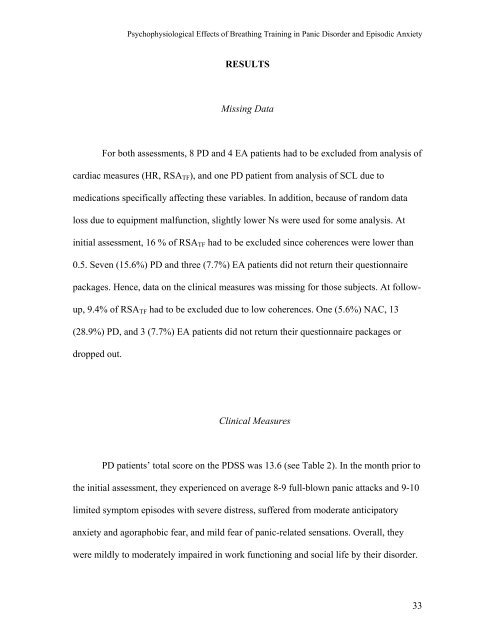Psych. Eileen Wollburg
Psych. Eileen Wollburg
Psych. Eileen Wollburg
You also want an ePaper? Increase the reach of your titles
YUMPU automatically turns print PDFs into web optimized ePapers that Google loves.
<strong>Psych</strong>ophysiological Effects of Breathing Training in Panic Disorder and Episodic Anxiety<br />
RESULTS<br />
Missing Data<br />
For both assessments, 8 PD and 4 EA patients had to be excluded from analysis of<br />
cardiac measures (HR, RSATF), and one PD patient from analysis of SCL due to<br />
medications specifically affecting these variables. In addition, because of random data<br />
loss due to equipment malfunction, slightly lower Ns were used for some analysis. At<br />
initial assessment, 16 % of RSATF had to be excluded since coherences were lower than<br />
0.5. Seven (15.6%) PD and three (7.7%) EA patients did not return their questionnaire<br />
packages. Hence, data on the clinical measures was missing for those subjects. At follow-<br />
up, 9.4% of RSATF had to be excluded due to low coherences. One (5.6%) NAC, 13<br />
(28.9%) PD, and 3 (7.7%) EA patients did not return their questionnaire packages or<br />
dropped out.<br />
Clinical Measures<br />
PD patients’ total score on the PDSS was 13.6 (see Table 2). In the month prior to<br />
the initial assessment, they experienced on average 8-9 full-blown panic attacks and 9-10<br />
limited symptom episodes with severe distress, suffered from moderate anticipatory<br />
anxiety and agoraphobic fear, and mild fear of panic-related sensations. Overall, they<br />
were mildly to moderately impaired in work functioning and social life by their disorder.<br />
33

















